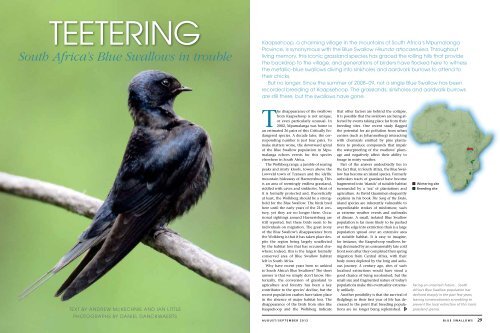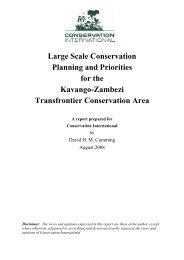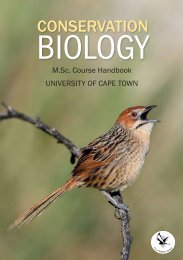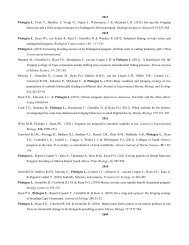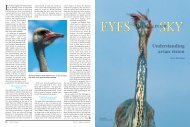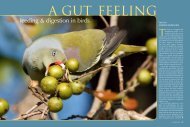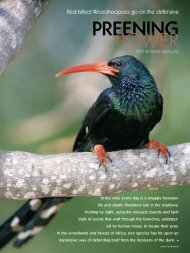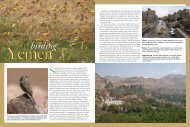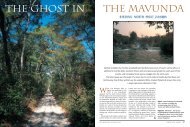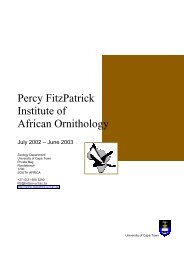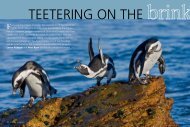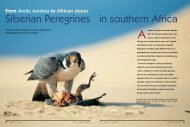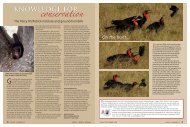South Africa's Blue Swallows in trouble - Percy FitzPatrick Institute of ...
South Africa's Blue Swallows in trouble - Percy FitzPatrick Institute of ...
South Africa's Blue Swallows in trouble - Percy FitzPatrick Institute of ...
You also want an ePaper? Increase the reach of your titles
YUMPU automatically turns print PDFs into web optimized ePapers that Google loves.
teeter<strong>in</strong>g<strong>South</strong> Africa’s <strong>Blue</strong> <strong>Swallows</strong> <strong>in</strong> <strong>trouble</strong>Kaapsehoop, a charm<strong>in</strong>g village <strong>in</strong> the mounta<strong>in</strong>s <strong>of</strong> <strong>South</strong> Africa’s MpumalangaProv<strong>in</strong>ce, is synonymous with the <strong>Blue</strong> Swallow Hirundo atrocaerulea. Throughoutliv<strong>in</strong>g memory, this iconic grassland species has graced the roll<strong>in</strong>g hills that providethe backdrop to the village, and generations <strong>of</strong> birders have flocked here to witnessthe metallic-blue swallows div<strong>in</strong>g <strong>in</strong>to s<strong>in</strong>kholes and aardvark burrows to attend totheir chicks.But no longer. S<strong>in</strong>ce the summer <strong>of</strong> 2008–09, not a s<strong>in</strong>gle <strong>Blue</strong> Swallow has beenrecorded breed<strong>in</strong>g at Kaapsehoop. The grasslands, s<strong>in</strong>kholes and aardvark burrowsare still there, but the swallows have gone.Text by Andrew McKechnie and Ian LittlePhotographs by Daniel DanckwaertsThe disappearance <strong>of</strong> the swallowsfrom Kaapsehoop is not unique,or even particularly unusual. In2002, Mpumalanga was home toan estimated 26 pairs <strong>of</strong> this Critically Endangeredspecies. A decade later, the correspond<strong>in</strong>gnumber is just four pairs. Tomake matters worse, the downward spiral<strong>of</strong> the <strong>Blue</strong> Swallow population <strong>in</strong> Mpumalangaechoes events for this specieselsewhere <strong>in</strong> <strong>South</strong> Africa.The Wolkberg range, a jumble <strong>of</strong> soar<strong>in</strong>gpeaks and misty klo<strong>of</strong>s, towers above theLowveld town <strong>of</strong> Tzaneen and the idyllicmounta<strong>in</strong> hideaway <strong>of</strong> Haenertsburg. Thisis an area <strong>of</strong> seem<strong>in</strong>gly endless grassland,riddled with caves and s<strong>in</strong>kholes. Most <strong>of</strong>it is formally protected and, theoreticallyat least, the Wolkberg should be a strongholdfor the <strong>Blue</strong> Swallow. The birds bredhere until the early years <strong>of</strong> the 21st century,yet they are no longer there. Occasionalsight<strong>in</strong>gs around Haenertsburg arestill reported, but these birds seem to be<strong>in</strong>dividuals on migration. The great irony<strong>of</strong> the <strong>Blue</strong> Swallow’s disappearance fromthe Wolkberg is that it has taken place despitethe region be<strong>in</strong>g largely unaffectedby the habitat loss that has occurred elsewhere;<strong>in</strong>deed, this is the largest formallyconserved area <strong>of</strong> <strong>Blue</strong> Swallow habitatleft <strong>in</strong> <strong>South</strong> Africa.Why have recent years been so unk<strong>in</strong>dto <strong>South</strong> Africa’s <strong>Blue</strong> <strong>Swallows</strong>? The shortanswer is that we simply don’t know. Historically,the conversion <strong>of</strong> grassland toagriculture and forestry has been a keycontributor to the species’ decl<strong>in</strong>e, but therecent population crashes have taken place<strong>in</strong> the absence <strong>of</strong> major habitat loss. Thedisappearance <strong>of</strong> the birds from sites likeKaapsehoop and the Wolkberg <strong>in</strong>dicatethat other factors are beh<strong>in</strong>d the collapse.It is possible that the swallows are be<strong>in</strong>g affectedby events tak<strong>in</strong>g place far from theirbreed<strong>in</strong>g sites. One recent study flaggedthe potential for air pollution from urbancentres (such as Johannesburg) <strong>in</strong>teract<strong>in</strong>gwith chemicals emitted by p<strong>in</strong>e plantationsto produce compounds that impairthe water pro<strong>of</strong><strong>in</strong>g <strong>of</strong> the swallows’ plumageand negatively affect their ability t<strong>of</strong>orage <strong>in</strong> misty weather.Part <strong>of</strong> the answer undoubtedly lies <strong>in</strong>the fact that, <strong>in</strong> <strong>South</strong> Africa, the <strong>Blue</strong> Swallowhas become an island species. Formerlyunbroken tracts <strong>of</strong> grassland have becomefragmented <strong>in</strong>to ‘islands’ <strong>of</strong> suitable hab itatsurrounded by a ‘sea’ <strong>of</strong> plantations andagriculture. As David Quammen eloquentlyexpla<strong>in</strong>s <strong>in</strong> his book The Song <strong>of</strong> the Dodo,island species are <strong>in</strong>herently vulnerable tounpredictable strokes <strong>of</strong> misfortune, suchas extreme weather events and outbreaks<strong>of</strong> disease. A small, isolated <strong>Blue</strong> Swallowpopulation is far more likely to be pushedover the edge <strong>in</strong>to ext<strong>in</strong>ction than is a largepopulation spread over an extensive area<strong>of</strong> suitable habitat. It is easy to ima g<strong>in</strong>e,for <strong>in</strong>stance, the Kaapsehoop swallows be<strong>in</strong>gdecimated by an unseasonably late coldfront soon after they completed their spr<strong>in</strong>gmigration from Central Africa, with theirbody stores depleted by the long and arduousjourney. A century ago, sites <strong>of</strong> suchlocalised ext<strong>in</strong>ctions would have stood agood chance <strong>of</strong> be<strong>in</strong>g recolonised, but thesmall size and fragmented nature <strong>of</strong> today’spopulations make this eventuality extremelyunlikely.Another possibility is that the survival <strong>of</strong>fledgl<strong>in</strong>gs <strong>in</strong> their first year <strong>of</strong> life has decreasedto the po<strong>in</strong>t that breed<strong>in</strong>g populationsare no longer be<strong>in</strong>g replenished.W<strong>in</strong>ter<strong>in</strong>g siteBreed<strong>in</strong>g siteFac<strong>in</strong>g an uncerta<strong>in</strong> future... <strong>South</strong>Africa’s <strong>Blue</strong> Swallow population hasdecl<strong>in</strong>ed sharply <strong>in</strong> the past few years,leav<strong>in</strong>g conservationists scrambl<strong>in</strong>g toprevent the local ext<strong>in</strong>ction <strong>of</strong> this iconicgrassland species.august/september 2012blue swallows29
Solv<strong>in</strong>g the riddle <strong>of</strong> the <strong>Blue</strong> Swallow’s <strong>trouble</strong>sis made more difficult by the lack <strong>of</strong> <strong>in</strong>formationsurround<strong>in</strong>g many fundamental aspects <strong>of</strong> itsnatural historyBelow <strong>Blue</strong> Swallow nestl<strong>in</strong>gs <strong>in</strong> KwaZulu-Natal are currently be<strong>in</strong>g microchipped <strong>in</strong>an effort to identify the <strong>in</strong>dividuals us<strong>in</strong>g aparticular nest <strong>in</strong> successive years.Below, right Ian Little from the EndangeredWildlife Trust checks a nest site for breed<strong>in</strong>gactivity.Opposite Go<strong>in</strong>g, go<strong>in</strong>g, gone? Unlessthe current decl<strong>in</strong>e <strong>in</strong> the <strong>South</strong> Africanpopulation is halted, we will soon needto travel to the Eastern Highlands <strong>of</strong>Zimbabwe to see active <strong>Blue</strong> Swallow nests.Even seem<strong>in</strong>gly small reductions <strong>in</strong> habitatquality along migration routes, forex ample, may prove to be an <strong>in</strong>surmountablechallenge for young birds at a time <strong>in</strong>their life that is energet ically stressful. Thedecreased survival <strong>of</strong> juvenile birds <strong>in</strong> aspecies that has a generation length <strong>of</strong> onlythree years could easily be the reason forthe loss <strong>of</strong> small, fragmented populationsfrom the breed<strong>in</strong>g grounds, as has been occurr<strong>in</strong>g<strong>in</strong> <strong>South</strong> Africa and Swaziland <strong>in</strong>recent years.Solv<strong>in</strong>g the riddle <strong>of</strong> the <strong>Blue</strong> Swallow’s<strong>trouble</strong>s is made more difficult by the lack<strong>of</strong> <strong>in</strong>formation surround<strong>in</strong>g many fundamentalaspects <strong>of</strong> its natural history. Eventhe ‘fact’ that <strong>in</strong>dividual birds return tothe same nest site <strong>in</strong> successive seasonshas not yet been verified; with one possibleexception, there have been no recoveries<strong>of</strong> r<strong>in</strong>ged <strong>in</strong>dividuals. In this regardat least, there is light at the end <strong>of</strong> the tunnel.It is now feasible to remotely identify<strong>in</strong>dividuals fly<strong>in</strong>g <strong>in</strong>to particular nest sitesus<strong>in</strong>g passive <strong>in</strong>tegrated transponder (PIT)tags, the same rice-gra<strong>in</strong>-sized devicesused to microchip domestic pets.Dur<strong>in</strong>g the summer <strong>of</strong> 2011–12, a teamfrom the Endangered Wildlife Trust (EWT)started PIT-tagg<strong>in</strong>g <strong>Blue</strong> Swallow nestl<strong>in</strong>gs<strong>in</strong> KwaZulu-Natal. From late 2012, nestsites will be monitored for return<strong>in</strong>g birdsby position<strong>in</strong>g a PIT-tag reader near theburrow entrance to record the iden tities <strong>of</strong>any tagged <strong>in</strong>dividuals fly<strong>in</strong>g to the nest.The value <strong>of</strong> this long-term project extendsfar beyond simply establish<strong>in</strong>g whether<strong>in</strong>dividuals return to the same nest site<strong>in</strong> successive seasons. It will, for <strong>in</strong>stance,also yield vital <strong>in</strong>formation on cooperativebreed<strong>in</strong>g <strong>in</strong> the swallows by identify<strong>in</strong>g <strong>in</strong>dividualsother than the parents that maybe <strong>in</strong>volved <strong>in</strong> rais<strong>in</strong>g young.Another problem fac<strong>in</strong>g conservationistsis that very little is known about the<strong>Blue</strong> Swallow’s migration routes. As faras we know, birds that breed <strong>in</strong> <strong>South</strong> Africa,Swaziland, Zimbabwe, Malawi andsouthern Tanzania all spend the w<strong>in</strong>ter<strong>in</strong> seasonally flooded grasslands aroundLake Victoria, at sites such as Sango Bay <strong>in</strong>Uganda. However it rema<strong>in</strong>s unclear, forexample, whether birds from the <strong>South</strong>African breed<strong>in</strong>g grounds use the samew<strong>in</strong>ter<strong>in</strong>g sites as Zimbabwean birds.A stable-isotope project led by the lateJames Wakel<strong>in</strong> (see Africa – Birds & Bird<strong>in</strong>g14(5): 36–40) has shed some light onthis question, reveal<strong>in</strong>g that birds fromdifferent breed<strong>in</strong>g grounds are dist<strong>in</strong>guishableon the basis <strong>of</strong> the biochemicalian littletanya smith30 blue swallows
Identify<strong>in</strong>g the routes taken by <strong>Blue</strong><strong>Swallows</strong> migrat<strong>in</strong>g between theirbreed<strong>in</strong>g and w<strong>in</strong>ter<strong>in</strong>g grounds iscritical for the species’ conservation.GAUTENGLIMPOPOFREESTATELESOTHOEASTERN CAPEMPUMALANGAHaenertsburgGraskopKaapsehoopKWAZULUNATALGreytownIxopoHard<strong>in</strong>gPigg’sPeakSWAZILANDNkandlaNgomeMOZAMBIQUEINDIANOCEANGAUTENGLIMPOPOFREESTATELESOTHOEASTERN CAPEMPUMALANGAHaenertsburgGraskopKaapsehoopKWAZULUNATALGreytownIxopoHard<strong>in</strong>gPigg’sPeakSWAZILANDNkandlaNgomeMOZAMBIQUEINDIANOCEANGAUTENGsignatures <strong>of</strong> their feathers. When theisotope ratios <strong>of</strong> feathers from sevenswallows caught by Wakel<strong>in</strong> at Sango Bay<strong>in</strong> 2005 were analysed, the data suggestedthat four <strong>of</strong> the birds orig<strong>in</strong>ated fromthe breed<strong>in</strong>g population <strong>in</strong> <strong>South</strong> Africa/Swaziland and a further two belonged tothe Malawian/Tanzanian breed<strong>in</strong>g population.Future studies <strong>in</strong>volv<strong>in</strong>g analyses<strong>of</strong> more feathers from w<strong>in</strong>ter<strong>in</strong>g birdswill hopefully allow us to better understandthe connections between variousbreed<strong>in</strong>g and non-breed<strong>in</strong>g sites.Know<strong>in</strong>g where specific breed<strong>in</strong>g populationsspend the w<strong>in</strong>ter months willbe a key element <strong>in</strong> solv<strong>in</strong>g the riddle<strong>of</strong> the species’ decl<strong>in</strong>e. But we also needto know the exact routes that migrat<strong>in</strong>gswallows follow between their breed<strong>in</strong>gand w<strong>in</strong>ter<strong>in</strong>g areas, because factorsalong migration routes could also be<strong>in</strong>strumental <strong>in</strong> the recent decl<strong>in</strong>e. Themost significant obstacle <strong>in</strong> this regardis the swallow’s small size. Whereas satellitetransmitters are currently availablefor large-bodied groups such asflam<strong>in</strong>gos, waterfowl and large raptors,even the smallest transmitters are toobig and heavy to mount on a swallowsizedbird. But there is glimmer <strong>of</strong> hope:a Polish company is manufactur<strong>in</strong>gLIMPOPOFREESTATELESOTHOEASTERN CAPEMPUMALANGAHaenertsburgKWAZULUNATALGreytownIxopoHard<strong>in</strong>gGraskopKaapsehoopPigg’sPeakSWAZILANDNkandlaNgomeMOZAMBIQUEINDIANOCEANDistribution <strong>in</strong> <strong>South</strong> Africa <strong>of</strong> the <strong>Blue</strong> Swallow <strong>in</strong> the 1800s (left), 2005 (centre) and 2012 (right). Red crosses <strong>in</strong>dicate local ext<strong>in</strong>ctionsthat have taken place s<strong>in</strong>ce 2005. Data for the 1800s and 2005 from Evans & Bouwman (2010), Bird Conserv. Int. 20:1–15.devices that weigh just 1.3 grams and useGPS signals to log the position <strong>of</strong> an animalat regular <strong>in</strong>tervals. These data canthen be downloaded from distances <strong>of</strong>up to about 20 metres. While 1.3 grams isstill too heavy for a 13-gram <strong>Blue</strong> Swallowto carry, hopefully these devices will becomesmaller and lighter. Perhaps by theend <strong>of</strong> the decade it will be feasible to attachsuch a device to a <strong>Blue</strong> Swallow anddownload detailed tracks <strong>of</strong> its north- andsouthwards migration when it returns thefollow<strong>in</strong>g season.What does the futurehold for the <strong>Blue</strong>Swallow? Of all itsmajor range states,<strong>South</strong> Africa is by far theone whose populationseems to be most <strong>in</strong> perilIn March 2012, representatives fromnearly all the <strong>Blue</strong> Swallow’s rangestates met <strong>in</strong> KwaZulu-Natal. Thegoal <strong>of</strong> the workshop, which wasfunded by the <strong>FitzPatrick</strong> <strong>Institute</strong>, was totake stock <strong>of</strong> the current status <strong>of</strong> the swallowand update the Species Action Planthat was formulated at a similar meet<strong>in</strong>ga decade earlier at Kaapsehoop. The datapresented by the delegates reiterated theprecarious state <strong>of</strong> the <strong>South</strong> African andSwazi populations and confirmed thatthe species’ strongholds are the easternZimbabwe highlands, the Nyika Plateau<strong>in</strong> northern Malawi and the highlands <strong>of</strong>south-western Tanzania.A key issue to emerge from the workshopis that the Tanzanian refuge, which comprisesa vast area <strong>of</strong> grassland and holds asizable number <strong>of</strong> the swallows, is fac<strong>in</strong>g amassive threat <strong>in</strong> the form <strong>of</strong> extensive forestrydevelopments that are be<strong>in</strong>g plannedfor the region. This is a mirror image <strong>of</strong>what happened to the once-extensive mistbeltgrasslands <strong>of</strong> Mpumalanga and theKwaZulu-Natal Midlands.It also emerged from the workshop thatthe species’ nest<strong>in</strong>g behaviour differs significantlyacross its range. Whereas birdsfrom <strong>South</strong> Africa/Swaziland, Zimbabweand Malawi build their nests almost exclusively<strong>in</strong> s<strong>in</strong>kholes and aardvark burrows,the Tanzanian birds nest <strong>in</strong> build<strong>in</strong>gs andunder bridges, <strong>in</strong> much the same manneras other swallow species. Interest<strong>in</strong>gly, thisbehaviour has also recently been documentedat a site <strong>in</strong> Zimbabwe, with a pair <strong>of</strong>swallows nest<strong>in</strong>g <strong>in</strong>doors <strong>in</strong> a busy kitchen.The review <strong>of</strong> the species’ current statusalso underscored how little is knownabout the population <strong>in</strong> the DemocraticRepublic <strong>of</strong> Congo (DRC). The swallowsare thought to breed <strong>in</strong> the Marungu highlands,west <strong>of</strong> the southern reaches <strong>of</strong> LakeTanganyika, and Upemba National Park <strong>in</strong>the far south-east. The w<strong>in</strong>ter<strong>in</strong>g area forthese birds seems to be the Lendu plateau<strong>in</strong> north-eastern DRC, across the borderfrom Uganda. These DRC swallows, whichit is suspected represent a geographicallydiscrete sub-population, are <strong>in</strong>trigu<strong>in</strong>g <strong>in</strong>that they seem to use much the same type<strong>of</strong> habitat on their w<strong>in</strong>ter<strong>in</strong>g grounds asthey do when breed<strong>in</strong>g, namely mid- tohigh-altitude grasslands. All the other subpopulationsbreed <strong>in</strong> montane grasslands,and their w<strong>in</strong>ter<strong>in</strong>g habitat consists <strong>of</strong>seasonally flooded grasslands <strong>in</strong>terspersedwith forest patches at lower altitudes <strong>in</strong>the area surround<strong>in</strong>g Lake Victoria.What does the future hold for the <strong>Blue</strong>Swallow? Of all its major range states,<strong>South</strong> Africa is by far the one whose populationseems to be most <strong>in</strong> peril. Withfewer than 40 nest<strong>in</strong>g pairs and 100 <strong>in</strong>dividualbirds rema<strong>in</strong><strong>in</strong>g, we have very littleroom <strong>in</strong> which to manoeuvre, and thenext few years will determ<strong>in</strong>e the fate <strong>of</strong>this ma jestic little bird <strong>in</strong> <strong>South</strong> Africa.Realistically, it seems highly unlikely thatthe Mpumalanga population will survivethe next five years. Although theKwa Zulu-Natal population is stable at present,the disquiet<strong>in</strong>g fact is that until veryrecently the same was true <strong>in</strong> Mpumalanga,and we have no way <strong>of</strong> predict<strong>in</strong>g if orwhen the same <strong>in</strong>explicable decl<strong>in</strong>es willbeg<strong>in</strong> among the KwaZulu-Natal birds.In this regard, the recent ext<strong>in</strong>ctions atNgome <strong>in</strong> northern KwaZulu-Natal andthe Bl<strong>in</strong>kwater Nature Reserve <strong>in</strong> the Midlandsare extremely concern<strong>in</strong>g. Unlesswe are able to identify the precise causes<strong>of</strong> recent population decl<strong>in</strong>es and implementurgent conservation <strong>in</strong>terventions,it is highly likely that the <strong>Blue</strong> Swallowwill be the third species (after the AfricanSkimmer and Egyptian Vulture) to becomeregionally ext<strong>in</strong>ct with<strong>in</strong> the borders <strong>of</strong><strong>South</strong> Africa.Artist Bruce Clements began sculpt<strong>in</strong>gat the age <strong>of</strong> six and he cont<strong>in</strong>uesto work <strong>in</strong> bronze <strong>in</strong> his pr<strong>of</strong>essionalcareer. He was taught by and has workedwith some <strong>of</strong> <strong>South</strong> Africa’s top artists,and photographs <strong>of</strong> his sculptures haveappeared <strong>in</strong>ternationally <strong>in</strong> newspapersand magaz<strong>in</strong>es, and on websites. He is<strong>in</strong>spired by the technical aspect <strong>of</strong> anyartistic challenge and his work as afoundryman has proved <strong>in</strong>valuable.Clements, who is ga<strong>in</strong><strong>in</strong>g a reputationas a specialist <strong>in</strong> sculpt<strong>in</strong>g endangeredspecies, donates half the proceeds fromthe sale <strong>of</strong> his work to the conservation<strong>of</strong> the species concerned.This bronze sculpture forms part <strong>of</strong> alimited edition <strong>of</strong> 90, which represents theestimated number <strong>of</strong> <strong>Blue</strong> <strong>Swallows</strong> left <strong>in</strong><strong>South</strong> Africa. Each sculpture is mountedon an oiled teak base (recycled railwaysleeper) and sells for R3 000. The proceedswill go to the Endangered WildlifeTrust’s <strong>Blue</strong> Swallow conservation project.For orders or more <strong>in</strong>formation, contactBruce Clements on +27 (0)83 4341886 or e-mail bruceclements@hotmail.com, or Dr Ian Little, Manager: ThreatenedGrassland Species Programme,Endangered Wildlife Trust, on +27 (0)84240 7341 or e-mail ianl@ewt.org.za32 blue swallows AFRICA – BIRDS & BIRDINGaugust/september 2012 blue swallows 33


